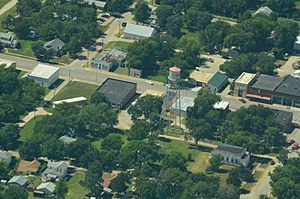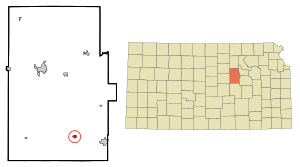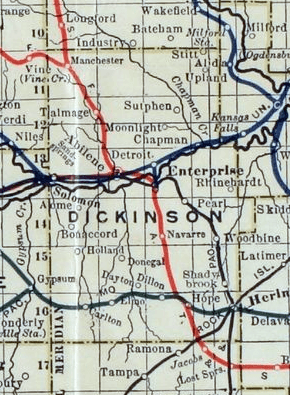Hope, Kansas facts for kids
Quick facts for kids
Hope, Kansas
|
|
|---|---|

Aerial photo of Hope (2013)
|
|

Location within Dickinson County and Kansas
|
|

|
|
| Country | United States |
| State | Kansas |
| County | Dickinson |
| Founded | 1871 |
| Incorporated | 1886 |
| Government | |
| • Type | Mayor–Council |
| Area | |
| • Total | 0.39 sq mi (1.01 km2) |
| • Land | 0.39 sq mi (1.01 km2) |
| • Water | 0.00 sq mi (0.00 km2) |
| Elevation | 1,398 ft (426 m) |
| Population
(2020)
|
|
| • Total | 317 |
| • Density | 813/sq mi (313.9/km2) |
| Time zone | UTC-6 (CST) |
| • Summer (DST) | UTC-5 (CDT) |
| ZIP code |
67451
|
| Area code | 785 |
| FIPS code | 20-33075 |
| GNIS ID | 2394416 |
Hope is a small city located in southern Dickinson County, Kansas, in the United States. As of the 2020 census, about 317 people live there.
Contents
History of Hope, Kansas

Early Beginnings of Kansas
For thousands of years, the Great Plains of North America were home to nomadic Native American tribes. They moved around, following animals and seasons.
From the 1500s to the 1700s, France claimed large parts of North America. After a war in 1762, France secretly gave this land to Spain.
In 1802, Spain returned most of the land to France. Then, in 1803, the United States bought a huge area, including what is now Kansas. This was called the Louisiana Purchase. It cost about 2.83 cents per acre.
In 1854, the Kansas Territory was set up. In 1861, Kansas officially became the 34th U.S. state. Dickinson County, where Hope is located, was created in 1857.
How Hope Was Developed
In 1871, a group of about 40 people, led by Newell Thurstin, started planning a new town. They named it Hope, after one of Thurstin's sons. The first post office opened in July 1871.
David Jacob Eisenhower, who was the father of President Dwight David Eisenhower, lived near Hope. He had a ranch there from 1878. Later, he moved into Hope itself.
In 1885, David Eisenhower and his business partner, Milton Good, opened a general store called Good & Eisenhower. They helped the town grow. Hope was officially made a city in 1886. At that time, over 700 people lived there.
The arrival of the railroad in 1885 was a big deal for Hope. It connected the small town to bigger cities like Chicago. In 1886, Eisenhower and Good helped raise money to open an opera house in Hope.
In 1887, the Atchison, Topeka and Santa Fe Railway built a train line that went through Hope. This railway later merged with another and is now called BNSF Railway.
The motto of Hope is "There Will Always Be Hope In Kansas." This phrase is also the title of a song.
Geography and Climate
Hope covers a total area of about 0.39 square miles (1.01 square kilometers). All of this area is land.
Understanding Hope's Climate
Hope has a climate with hot and humid summers. The winters are usually mild to cool. This type of weather is known as a humid subtropical climate.
Population and People
| Historical population | |||
|---|---|---|---|
| Census | Pop. | %± | |
| 1890 | 632 | — | |
| 1900 | 557 | −11.9% | |
| 1910 | 567 | 1.8% | |
| 1920 | 589 | 3.9% | |
| 1930 | 556 | −5.6% | |
| 1940 | 500 | −10.1% | |
| 1950 | 480 | −4.0% | |
| 1960 | 463 | −3.5% | |
| 1970 | 438 | −5.4% | |
| 1980 | 468 | 6.8% | |
| 1990 | 404 | −13.7% | |
| 2000 | 372 | −7.9% | |
| 2010 | 368 | −1.1% | |
| 2020 | 317 | −13.9% | |
| U.S. Decennial Census | |||
Hope's Population in 2020
The 2020 United States census counted 317 people living in Hope. There were 146 households and 82 families. About 21.8% of the people were under 18 years old. About 27.4% were 65 years or older. The average age in Hope was 51.5 years.
Hope's Population in 2010
In the census of 2010, there were 368 people living in Hope. There were 166 households. About 19.8% of the residents were under 18 years old. About 23.1% were 65 years or older. The average age in the city was 48.7 years.
Transportation in Hope
Hope is located on K-4, which is the longest highway in Kansas. Hope was once a stop for the BNSF and Missouri Pacific trains. However, trains no longer serve the city.
Notable People from Hope
- Edgar N. Eisenhower, who was the brother of President Dwight D. Eisenhower, was born in Hope, Kansas.
- Don Ihde, a well-known philosopher, was born in Hope, Kansas, in 1934.
See also
 In Spanish: Hope (Kansas) para niños
In Spanish: Hope (Kansas) para niños


